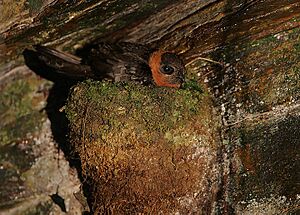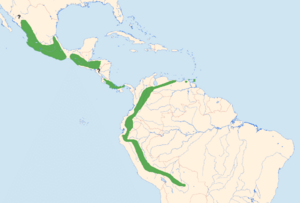Chestnut-collared swift facts for kids
Quick facts for kids Chestnut-collared swift |
|
|---|---|
 |
|
| An adult male on the nest. | |
| Conservation status | |
| Scientific classification | |
| Genus: |
Streptoprocne
|
| Species: |
rutila
|
 |
|
| Range of Streptoprocne rutila | |
| Synonyms | |
|
|
The chestnut-collared swift (Streptoprocne rutila) is a type of bird in the swift family. Swifts are known for their fast flight. This bird lives in many places, from Mexico and Trinidad in the north, all the way south to Peru and Bolivia.
Contents
About the Chestnut-collared Swift
The chestnut-collared swift is one of the smaller swifts in its group. It is about 12 to 14 cm (4.7 to 5.5 in) long. This is roughly the length of a small ruler. It weighs about 21 g (0.74 oz), which is very light.
What Does It Look Like?
This swift has a wide tail that is slightly notched. Its wings are broad, helping it fly quickly.
Adult male swifts have a dark, sooty blackish-brown head and back. Their tail is also dark. They have a thin black patch around their eyes. Their cheeks and throat are grayish-brown. The most special part is a wide, reddish-brown collar. This collar goes across their lower throat and upper chest, wrapping around to the back of their neck. Their wings are black on top and a bit lighter underneath. Their belly is a lighter blackish-brown.
Female swifts look a bit paler than males. Their reddish-brown collar is much smaller, or sometimes they don't have one at all. Young swifts look like adult females but are even paler.
There are three main types, or subspecies, of this swift:
- S. r. griseifrons
- S. r. brunnitorques
- S. r. rutila
One subspecies, S. r. griseifrons, has sooty gray upper parts instead of black. Its belly is grayish-brown. Another subspecies, S. r. brunnitorques, looks very similar to the main type, S. r. rutila.
Where Do They Live?
The chestnut-collared swift lives in different parts of North and South America.
- S. r. griseifrons lives in western Mexico.
- S. r. brunnitorques is found from southeastern Mexico through Central America. It also lives along the Andes mountains in Colombia, Ecuador, Bolivia, and Peru.
- S. r. rutila lives in the Andes and Coastal Ranges of Venezuela, and on the island of Trinidad.
These birds live in many kinds of places. You can find them in humid mountain forests and pine forests. They also live in areas with semi-open spaces and even near small towns. They can live from just a few hundred meters above sea level up to very high elevations. For example, in Mexico, they can be found as high as 3,000 m (9,800 ft) (about 9,800 feet).
How Do They Behave?
Daily Life and Travel
Chestnut-collared swifts usually stay in the same area all year. However, they might move to different spots nearby depending on the season.
What Do They Eat?
Like all swifts, these birds catch and eat insects while flying. They are aerial insectivores. We don't know all the details of their diet. But we do know they eat different kinds of insects. Some studies show they like flying ants. Others suggest they prefer small beetles. What they eat might depend on what insects are available in their area.
They often hunt for food in groups of 10 to 20 birds. Sometimes, much larger groups gather to feed. They might even join other swift species. When they do, they usually fly near the top of the mixed group.
How Do They Raise Their Young?
The breeding season for these swifts changes depending on where they live. North of the equator, it's usually from May to August. We don't know as much about their breeding season closer to or below the equator.
They build their nests using mud and plant materials. These materials include moss, liverwort, and ferns. They place their nests on small ledges or in cracks on rock walls. These spots are usually damp and shady, often near water. You might find their nests in caves, under bridges, or inside culverts (tunnels for water).
Female swifts usually lay two eggs. Both parents take turns sitting on the eggs. This incubation period lasts for 22 to 23 days. The young birds are ready to fly, or fledge, about five to six weeks after they hatch.
What Do They Sound Like?
The call of the chestnut-collared swift when it's flying is often described as "buzzy." It sounds like electric crackles or static. Sometimes, these sounds are strung together into a chatter. It might sound like: bzzzz'tzz'tzz'tzz zz zzzz zzzzz zzzz.
Conservation Status
The IUCN (International Union for Conservation of Nature) has listed the chestnut-collared swift as a species of "Least Concern." This means they are not currently at high risk of disappearing. They live across a very large area. Their population is estimated to be at least 50,000 adult birds. Even though this number is believed to be slowly decreasing, there are no immediate major threats to them. Human activities probably don't affect the chestnut-collared swift very much.


